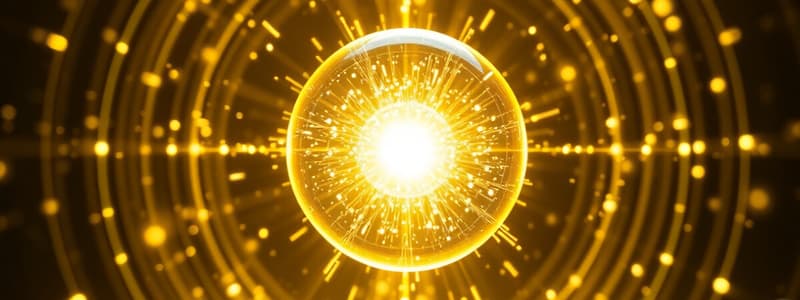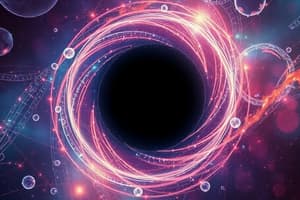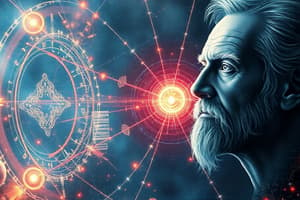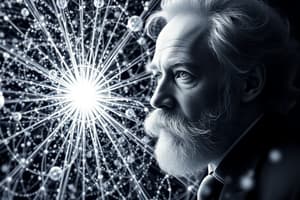Podcast
Questions and Answers
What concept introduced by Max Planck fundamentally changed the scientific understanding of energy?
What concept introduced by Max Planck fundamentally changed the scientific understanding of energy?
- Wave-particle duality
- Relativity
- Energy conservation
- Energy quanta (correct)
What challenge did Planck aim to address in physics during the 1890s?
What challenge did Planck aim to address in physics during the 1890s?
- Explaining blackbody radiation (correct)
- Defining gravitational waves
- Establishing the principles of thermodynamics
- Quantifying electromagnetic forces
Which of the following did NOT directly result from Max Planck's quantum theory?
Which of the following did NOT directly result from Max Planck's quantum theory?
- Support for the theory of evolution (correct)
- Development of quantum mechanics
- Challenge to classical physics
- Refinement of atomic theory
What was one of the key implications of Planck's assertion that energy is quantized?
What was one of the key implications of Planck's assertion that energy is quantized?
Which position did Max Planck hold towards the end of his career?
Which position did Max Planck hold towards the end of his career?
What did Max Planck discover about the vibration frequencies of atoms?
What did Max Planck discover about the vibration frequencies of atoms?
Which concept is associated with Planck's constant?
Which concept is associated with Planck's constant?
What significant contribution did Paul Dirac make to physics?
What significant contribution did Paul Dirac make to physics?
What fundamental idea did Planck's investigation challenge in classical physics?
What fundamental idea did Planck's investigation challenge in classical physics?
How did Dirac's work enhance existing quantum mechanics?
How did Dirac's work enhance existing quantum mechanics?
What discovery did Max Planck make about atomic vibrations?
What discovery did Max Planck make about atomic vibrations?
What is the relationship between energy and frequency as defined by Planck's radiation law?
What is the relationship between energy and frequency as defined by Planck's radiation law?
What does Planck's constant represent in physics?
What does Planck's constant represent in physics?
Which scientist developed the Dirac equation and predicted the existence of antimatter?
Which scientist developed the Dirac equation and predicted the existence of antimatter?
What is the significance of Planck's length and time in modern physics?
What is the significance of Planck's length and time in modern physics?
How many times has Planck's work been recognized with a Nobel Prize in Physics?
How many times has Planck's work been recognized with a Nobel Prize in Physics?
What prompted the development of quantum field theory according to Paul Dirac's research?
What prompted the development of quantum field theory according to Paul Dirac's research?
What is the primary concept underlying Planck's theory of light?
What is the primary concept underlying Planck's theory of light?
What does Planck's radiation law primarily describe?
What does Planck's radiation law primarily describe?
What role did Albert Einstein play in relation to Planck's hypothesis?
What role did Albert Einstein play in relation to Planck's hypothesis?
What is the significance of Planck's constant (h) in Planck's radiation law?
What is the significance of Planck's constant (h) in Planck's radiation law?
What are Planck length and Planck time used to define?
What are Planck length and Planck time used to define?
How many times was Max Planck nominated for the Nobel Prize in Physics?
How many times was Max Planck nominated for the Nobel Prize in Physics?
What was the primary outcome of introducing quantum theory according to Max Planck?
What was the primary outcome of introducing quantum theory according to Max Planck?
Which of the following aspects did Planck's calculations primarily address?
Which of the following aspects did Planck's calculations primarily address?
What year did Max Planck publish his influential thoughts on quantum theory?
What year did Max Planck publish his influential thoughts on quantum theory?
According to the quote, what does Planck imply about the nature of physics following the introduction of quantum theory?
According to the quote, what does Planck imply about the nature of physics following the introduction of quantum theory?
What overarching theme can be derived from Planck's statement about the impact of quantum theory?
What overarching theme can be derived from Planck's statement about the impact of quantum theory?
Flashcards
What is a blackbody?
What is a blackbody?
A hypothetical object that absorbs all electromagnetic radiation (light) and re-emits it as waves of different wavelengths.
What did Planck's Quantum Theory state?
What did Planck's Quantum Theory state?
Max Planck proposed that energy is emitted not continuously but in discrete packets called "quanta".
Who was Max Planck?
Who was Max Planck?
A German physicist who revolutionized physics with his discovery of energy quanta.
What problem did Planck solve?
What problem did Planck solve?
Signup and view all the flashcards
What was the impact of Planck's work?
What was the impact of Planck's work?
Signup and view all the flashcards
Planck's Constant
Planck's Constant
Signup and view all the flashcards
Quantum Theory
Quantum Theory
Signup and view all the flashcards
Blackbody
Blackbody
Signup and view all the flashcards
Dirac Equation
Dirac Equation
Signup and view all the flashcards
Quantum Mechanics
Quantum Mechanics
Signup and view all the flashcards
What is Planck Length?
What is Planck Length?
Signup and view all the flashcards
What is Planck Time?
What is Planck Time?
Signup and view all the flashcards
What is Planck's constant (h)?
What is Planck's constant (h)?
Signup and view all the flashcards
What is Planck's quantum theory?
What is Planck's quantum theory?
Signup and view all the flashcards
What is Planck's radiation law?
What is Planck's radiation law?
Signup and view all the flashcards
What is quantum theory?
What is quantum theory?
Signup and view all the flashcards
Planck's Constant (h)
Planck's Constant (h)
Signup and view all the flashcards
Planck Length
Planck Length
Signup and view all the flashcards
Planck Time
Planck Time
Signup and view all the flashcards
Planck's Quantum Theory
Planck's Quantum Theory
Signup and view all the flashcards
Photoelectric Effect
Photoelectric Effect
Signup and view all the flashcards
Max Planck
Max Planck
Signup and view all the flashcards
Quantum
Quantum
Signup and view all the flashcards
Planck's Radiation Law
Planck's Radiation Law
Signup and view all the flashcards
Reconstructing Physics
Reconstructing Physics
Signup and view all the flashcards





